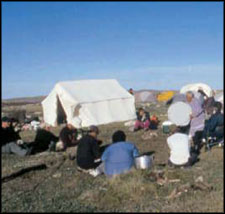
Inuit elders, students, and archaeologists share songs and history during a drum dance at the Iqaluktuuq elders’ traditional knowledge camp (Max Friesen).

Historically, Iqaluktuurmiut spent their winters on the sea ice hunting seals. They first started moving towards the land in the spring. Iqaluktuurmiut moved to fishing lakes to catch iqalukpiit (arctic char) and ihuuraryuit (lake trout) through the ice. One of those important spring fishing lakes was Tahiryuaq (Ferguson Lake) which is drained by Iqaluktuuq. Fishing at the ocean’s edge or on the lake ice in the spring was done with an aulajjut (jigger) and qaryuqaq (fishing hook); or alternatively with an aulajjut and iqaluuyaq (fish shaped lure without a hook), and a kakivak (fish spear) or leister. The iqaluuyaq was used to lure in the fish close enough that it could be speared with the kakivak.
As the edge of the lakes melted, char and lake trout began to move along the ice edge. Iqaluktuurmiut used specialized fish spears at this time of year, and they wore a type of waterproof boot called an ipirauhiq to guard against the cold water. One of the spears was a one or two pronged fishing harpoon called a naulaqtuut. The naulaqtuut had a wooden handle and antler foreshaft with an antler harpoon head tied tightly to it. It doesn’t appear that any early explorers or ethnographers collected an example of this spear and so no photographs are available. However, some Elders still remember the design and use of the naulaqtuut. The other type of fishing spear was the nuiyaaqpait (nuiyaaqpak) or trident – a fishing spear with three barbed prongs made of caribou antler (see Kapuutit section on page 7).
During the months of May and June Iqaluktuurmiut hunted the returning caribou and made mipku (dried meat). In June the char began to run downstream out of Tahiryuaq through Iqaluktuuq to the ocean. Iqaluktuurmiut fished intensively at this time using the kakivak, and with the warm weather of summer, they had to dry the fish to preserve it so it would be available for consumption in the winter.
In late August the char began to run up Iqaluktuuq from the ocean to Tahiryuaq. This was another time of intensive fishing with the kakivak. As the weather was significantly cooler at this time of year, Iqaluktuurmiut were able to cache whole fish in a rectangular shaped cache called a qinngniq without fear that the fish would rot. The floor of a qinngniq was made of flat rocks, or of a wooden lattice. This kept the cached fish off the moist ground.
![]() Ikpakuak Fishing in Lake
Ekallugak, Northwest Territories, May 15, 1915 (Diamond Jenness/CMC/36971).
Ikpakuak Fishing in Lake
Ekallugak, Northwest Territories, May 15, 1915 (Diamond Jenness/CMC/36971).
![]() Fishing Rod, line and hook
collected by Joseph F. Bernard (CMC /IV-D-1637).
Fishing Rod, line and hook
collected by Joseph F. Bernard (CMC /IV-D-1637).
![]() Fishing Lure made from
polar bear tooth (CMC/IV-D-431).
Fishing Lure made from
polar bear tooth (CMC/IV-D-431).